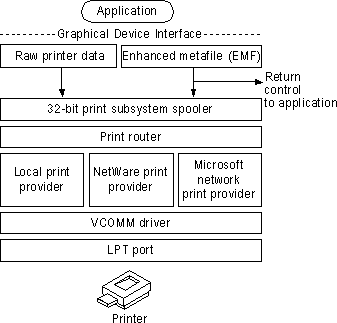
In Windows 3.1, print spooling functionality was handled by Print Manager and supported by code in several different Windows-based components. The Print Manager passed a fixed amount of information to the printer whether the printer was ready to receive it or not, causing what seemed to be jerky processing.
In Windows 95, the print spooler is implemented as a series of 32-bit virtual device drivers and DLLs, and consolidates the spooler functionality into a single architecture. The new spooler provides smooth background printing by using background thread processing. This means that the spooler passes data to the printer only when the printer is ready to receive more information.
The new spooler provides quick return-to-application time and is much more powerful and flexible. It allows you to set printer properties on a per-printer basis instead of requiring global printing properties as in Windows 3.1. For example, each printer can have a different separator page and each can specify whether jobs will be printed directly or to a queue.
The following diagram illustrates how Windows 95 prints documents.

For information about enhanced metafiles, printer drivers, ECP, and other components of the printing subsystem, see "Technical Notes on Windows 95 Printing" later in this chapter. The following sections describe how to install and share printers and how to use print servers on Windows NT and NetWare networks.